The Second World War, Volume IV: The Hinge of Fate by Winston S. Churchill
My rating: 5 of 5 stars
I find that I am liking each one of these volumes more than the last. The pleasure of this history is that, through the eyes of Winston Churchill, the war takes the shape of an enormous board game, played over months and years. Far removed from the gore of the front lines, Churchill sees the conflict as symbols on a map, which he needs to arrange in the most advantageous possible way—a game he plays brilliantly. This is not to say that he is frivolous or superficial. But warfare is far more palatable when experienced from the command chair than from the trenches.
Added to purely military decisions is the messier business of courting allies. Indeed, the best parts of this book describe Churchill’s cultivation of his relationships with Roosevelt and Stalin. Dealing with the Americans was relatively easy, as Roosevelt and Churchill seemed to have gotten along very well. Nevertheless, working so closely together required constant coordination of plans, both short-term and long-term; and Churchill sometimes struggled to get the American command to accept his military vision.
With Stalin, relations were far more tense. The Soviet leader is constantly demanding from Churchill fresh supplies and for a second front in France. Churchill, meanwhile, does his best to placate Stalin while firmly refusing to do what he feels is unwise. This culminates in his 1942 visit to Moscow, narrated in the two best chapters of the book. Churchill, sure that he will not be able to invade France in 1942, decides he must deliver this message personally if he is to maintain his working relationship with the Soviets. Stalin, at first, doesn’t take the news well, but by the end they are up all night, drinking vodka. In virtually any other circumstances, the two men would have been sworn enemies, and it is fascinating to see them try to cooperate.
The title of the book is quite apt, as it contains the battles that marked the beginning of the end for both Germany and Japan: Midway, Stalingrad, and Tunisia. These books, it should be remembered, are public memoirs rather than objective history; and so Stalingrad and Midway, being battles Churchill had nothing to do with, get only a cursory treatment. Northern Africa, on the other hand, occupies much of the book, as British and then American forces beat Rommel, invaded the Vichy territories, and finally won a decisive victory in Tunisia.
As a final thought, I am constantly surprised at how much I am learning from these books. Somehow, after a lifetime of World War II media, I knew close to nothing about operation “Torch,” and had no real idea of the significance of the Northern African campaigns. I was also unfamiliar with the Katyn massacres—Russia’s mass executions of Polish prisoners, an issue which Churchill felt he could not raise with the Soviets, for fear of hurting their relationship. Indeed, having been in Dresden just two weeks ago, I’ve had occasion to reflect that it was not only the axis who committed war crimes.
View all my reviews
Author: Roy Lotz
Pacífico: My Neighborhood
The city of Madrid is divided into 21 “districts,” which are further divided into 131 neighborhoods. Pacífico belongs to the Retiro district, so named for the iconic park which it encompasses. This neighborhood—along with its sister barrio, Adelfas—composes the southernmost part of this district, where some 50,000 reside. And for the last seven years, I have been one of them.
Pacífico is central without being in the center. Extremely well-connected by public transport—the Méndez Álvaro bus station is to the south, Atocha station to the west, the bus hub of Conde de Casal to the north, and two of the most important metro lines running through it—Pacífico is nevertheless quiet and residential, with no tourism to speak of.
I have had occasion to write about my neighborhood before. The beautiful (but obscure) Pantheon of Illustrious Men is located here, along with the Basílica of Atocha, where traditionally the royal family are baptized. Nearby is the Real Fabrica de Tápices, another fascinating place that most visitors overlook. This was built as a “royal factory” in the 18th century to make luxurious tapestries and carpets for the palaces; and it maintains this function to this day, though it is now privately owned. If you reserve in advance, you can visit the factory and see the workers painstakingly assembling enormous and intricate tapestries by hand, thread by thread.
As it is close to Atocha, the neighborhood is also rich in transport history. At the extreme western edge of Pacífico is the Museo La Neomudéjar, a modern art museum with rotating exhibits in a former train workshop. It is still full of decaying industrial ambience and abandoned equipment. Closer to where I live, you can visit the Nave de Motores, where the massive original power generators of the Madrid Metro are stored.
The administrative heart of the neighborhood, where the government offices are located, has a curious history. The building complex was first constructed as warehouses to store goods imported from abroad, for which it was known as “Los Docks” (yes, in English). This business soon failed, and it was turned into a military barracks, a function it maintained until 1981. After its acquisition by the municipal government, however, several historical buildings were demolished to make room for modern offices—a move widely criticized. The surviving original buildings have since been turned into a huge public sports center, with a gym, football and basketball courts, and a gigantic pool.
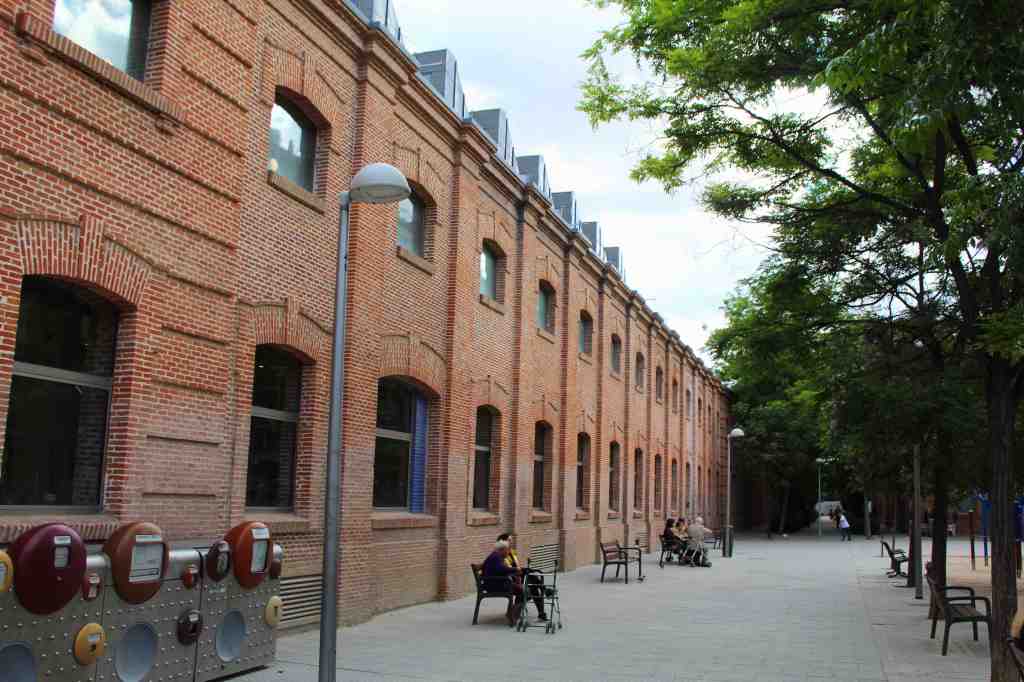
This sounds quite sunny and uplifting. Yet this sports center—named Daoíz y Velarde, after the Spaniards who instigated the uprising against Napoleon’s invading troops—has been touched by tragedy. For it was very near here, in 2004, where one of the bombs went off in the infamous March 11th terrorist attack (the train tracks run right by the buildings), and the sports center had to be used as a field hospital for the victims. 250 victims were treated there, of whom 10 lost their lives. A commemorative plaque marks the event.
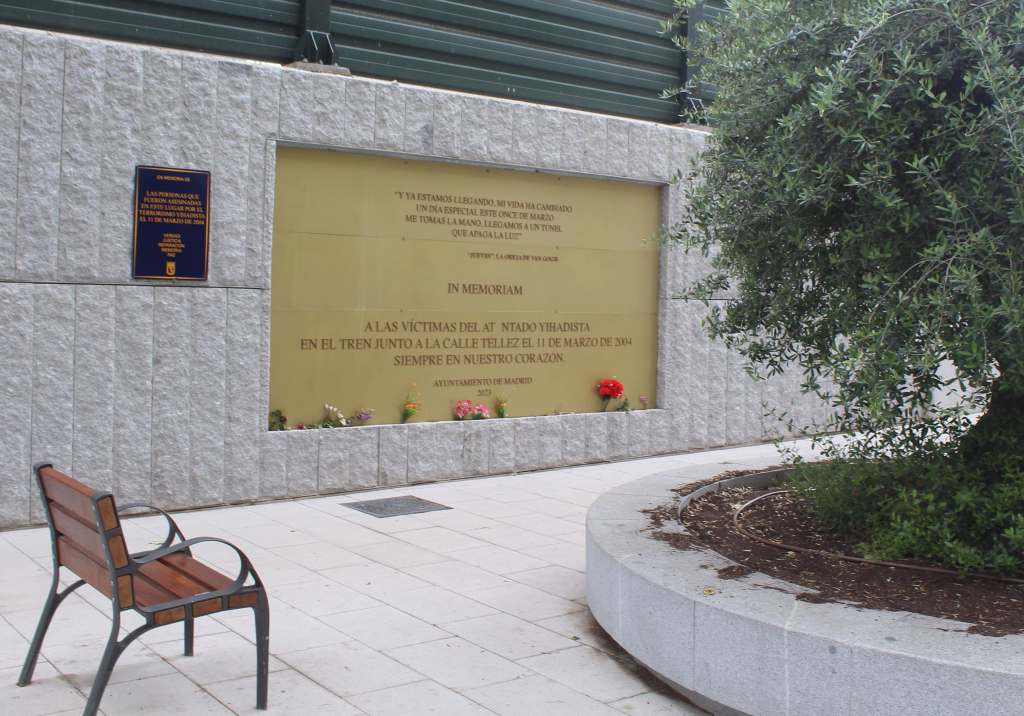
More recently, the Daoíz y Velarde Center has acquired an important music venue: the Real Teatro de Retiro. This is an offshoot of Spain’s royal opera house, where shows are tailored for a younger audience, with the aim of involving a new generation in classical music.
As interesting as all this history may be, it is not the reason I like to live here. Apart from being (for the moment) reasonably affordable and quite well connected by public transport, Pacífico is attractive for the wide variety of small businesses. Indeed, as an American, I am constantly surprised at the number of small, family-owned shops in Madrid. If you want to buy groceries, shoes, sports equipment, or whatever else in the United States, chances are you will find yourself at a strip mall, shopping at one of a small number of chains. Not so here.

My impression over all these years—though, I admit, it is little more than a vague one—is that the business landscape in Spanish cities resembles how American cities were ten or twenty years ago, before gentrification and consolidation took a toll on small business. However, I certainly do not know enough about the economy to argue the point.
Regardless, I think that these sorts of small, family-run neighborhood shops are a precious resource in any city, something worth preserving in the face of economic pressure. Thus, I set out to learn more about some of my favorite local businesses.
My first stop was my local ferretería (a hardware store and not, what some English speakers might think, a store specializing in ferrets). The Ferretería Pacífico has been around since 1995, and—judging by the constant flow of customers that made it difficult to ask questions—it is still going strong. I am a frequent customer myself, as the store sells everything from frying pans to drying racks to power tools. But my favorite service they offer is to sharpen knives.

The staff at the store are knowledgeable and friendly. And when I asked their secret to staying in business, they offered me an explanation that, though cliché, seems quite true: they offer customers personal attention. I have experience of this. When I was ineptly trying to install a curtain in my apartment, they talked me through the process and sold me everything I needed. When I asked what struggles they have remaining afloat as a business, I was given just one word in reply: “taxes.”
Somewhat further up the hill that leads to Retiro Park is my barber, Almudena. She works in the Pelúqueria Félix, a tiny barber shop on a quiet street. The shop is named after her father, who opened the business in 1976. Almudena learned her craft from him. She gives excellent haircuts, mostly eschewing the buzzer and working with a comb and scissors. When I asked about challenges, she also complained about taxes. The IVA (value-added tax) is 21%, meaning that a fifth of what is paid to her is for the government.
In addition, as somebody who is self-employed, Almudena must pay the “autónomo” tariff. This is a flat-rate fee that people who own their own businesses must pay in order to be legitimate. Strangely, this fee is relatively standard, varying only slightly depending on your income. Certainly I am in no position to judge the Spanish tax code, but as a general rule flat taxes are usually harder on the less fortunate.
The heart of the neighborhood, as far as shopping is concerned, is the traditional market—the Mercado de Pacífico. There are mercados del barrio all over the city, and they all have the same basic design: small stands selling high-quality products, often on a subterranean level. (I believe the reason that markets are often relegated to basements is to minimize the smell; fishmongers and pickled products are often present.)

There, while doing some shopping, I spoke with Francisco. He runs a fruit stand in the market, and has been at it for a long time. That’s an understatement: he is 70 now and started working in the market at the age of 13. I was delighted to notice that his scale was not in euros (adopted in 1999), but pesetas! When I offered to email Francisco this article, he showed me his old flip phone and told me that he didn’t use the internet. What a blissful existence!

Down the street is the oldest shop I was able to find, Zapatos San Román. It was opened in 1959 (as a certificate hung on the wall proudly states) by the father of the current owner, José. He has been working in the shop for 40 years, and still mans the cash register. The store is characterized by its giant “escaparate,” or old-fashioned display window. This is not limited, as in most stores, to a small cabinet out front; rather, the escaparate occupies fully half the store, wrapping around the visitor, creating a miniature landscape of shoes.

Down the street is another store devoted to footwear: Reparación de Calzado Alfaro. To be honest, I didn’t know that there were still professional cobblers in the world. The word itself, in English, calls to mind Victorian novels. But Rafael has been there for his whole professional life, following in his father’s footsteps, who opened the store in 1985. And he is doing very good business. When I visited him, so many customers came in that I had to retreat and return at a less busy time. But he does not only serve the locals, and not only the city of Madrid. Indeed, his business is not even limited to Spain. While there, he showed me an order that he had gotten from Belgium!

When I asked why he was doing so well, he said that his was a disappearing profession; and so anyone who needs a shoe fixed must search far and wide for a good cobbler. That search will, apparently, only get harder. Though Rafael inherited his business from his father, who himself learned from his own father, there will be no fourth generation of his shoe repair business. “It ends with me.” In response to my (perhaps silly) question of why people bother to get their shoes repaired, he told me a Spanish saying:“Te quiero más que a mis zapatos viejos.” That is, I love you more than my old shoes. And a pair of well-worn shoes are, indeed, something to cherish.

A bit up the block from my former apartment, on Calle de Cavanilles, there is a shop that holds a special place in my heart. It is Deportes Periso, a small sporting goods store. And it is special to me because, shortly before the Coronavirus Lockdown, I bought a pair of gray sweatpants there that got me through the isolation. Considering its size, the store has a lot of merchandise on offer—tennis rackets, sports jerseys, and lots of running shoes.

It was opened in 1978 by the current owner, Ana, and her father. As it happened, while I was there interviewing for this article, her father walked in. He’s in his 90s now and very personable. He told me about how the neighborhood had changed. Physically, he said, it has remained quite the same as it was decades ago.* But the demographics have changed. Since the 1980s, the neighborhood has gone from being mostly young to predominantly old. And of course there are more immigrants.
(*This isn’t exactly true. The big and unsightly Pedro Bosch bridge, which connects Pacífico with Méndez Álvaro, over the train tracks, was recently shortened and pedestrianized. And in general the neighborhood has become more bike friendly, with special bike lanes installed on Calle Doctor Esquerdo. However, there is still much progress to be made in that department, as evidenced by the death, just last month, of a bike delivery rider around the corner from my apartment. He was hit by a taxi in the early morning.)
But there are signs of encroaching gentrification. Across the street from Deportes Periso, for example, is an artisanal olive oil store; and considering how much the price of even store-brand olive oil has risen in the past year (well over 100%), one can imagine that people must have expendable income if they’re buying the fancy stuff.
Perhaps the most interesting small business I came across was that of Javier Pascual. He owns a merry-go-round that is parked in a small lot on the Avenida del Mediterráneo. He has been at it a long time, having established himself in the neighborhood in 1981. He comes from a family of carnival ride owners. Indeed, in the past, he owned more rides, but now operates just his “tiovivo” (as the Spanish call it, for some reason).

I have to admit that I was surprised that he could stay in business with a single carousel. Certainly it is hard for me to imagine anyone in my country making a living out of a merry-go-round. But again my expectations were disproven, as so many children came during my visit that I had to call off the interview and return later. (I didn’t have a ride myself, but it looked fun.) Javier works very hard. He’s open seven days a week, even Sundays. In the slow season, when Madrid empties out during the unbearable summer months, he packs up and goes to the fair in Cuenca. Then, he has his contraption repaired in August, ready to get back to work in September.

To round out this piece, I thought it right that I interview some of the more recent arrivals to my neighborhood. So I went to Union Frutas, a fruit stand near my house owned by a Chinese immigrant couple. I am a frequent customer, as the shop has very long hours (especially on Sunday, when so many stores close) and has extremely affordable prices. It has been open for 12 years. The husband, Diego (he goes by a Spanish name), moved to Spain in 2003 as a young man, following in the footsteps of his father, who lived in the Canary Islands. His wife, Li Fang, followed a few years later. When I asked Diego about the differences between work in Spain and his homeland, he replied that he had never had a job in China, so he couldn’t compare the experiences.


All of these stores have survived so long, in the face of competition from chains, by forging connections with the locals—something I witnessed in every shop I visited. It is small shops like these that give a neighborhood its flavor and personality, and which make Pacífico a wonderful place to live. And this is not even to mention the bars!
Review: Two Brecht Plays
Mother Courage and Her Children by Bertolt Brecht
My rating: 4 of 5 stars
The poor need courage. Why? They’re lost. That they even get up in the morning is something.
It is surprising to read, from such a famously doctrinaire thinker, a work of art that is so rich in moral ambiguity. The titular character is enormously compelling, despite being neither hero nor villain. Mother Courage has moments of courage, of course, but also of capitulation, moments wherein she is admirable and when she is despicable. She is, on the one hand, a war profiteer, a kind of jackal gnawing at the scraps of human carnage. But can a person living on the edge of poverty, with hardly any other viable option to make a living, be condemned?
The world that Brecht presents is as hopeless and absurd as in any work from the previous century. It is a world where both morality and immorality are rewarded with cruelty. Two of Mother Courage’s children are killed as a direct consequence of their attempts to do the right thing, whereas her oldest son is killed for his crimes (the same crimes, ironically, that were praised in wartime). Mother Courage herself, who at least survives, is moral within the bounds of practicality. Even when life and death are on the line, she is always a business woman first and foremost, unwilling to make any sacrifice that will jeopardize her ability to make a living.
Considering Brecth’s Marxism, I am tempted to view Mother Courage as a kind of embodiment of the evils of capitalism—or, at least, as a portrait of how capitalism degrades us. And certainly she is far from ennobled by her ceaseless dealings and negotiations. In perhaps the pivotal scene in the play, she convinces a soldier that protests against the powers that be are useless. Her worldview, in other words, is materialistic and cynical.
And yet it is the war, not the economy, that is the defining element of the setting. And it is a war of religion. Is Brecht showing us, then, how capitalists lack the moral ability to oppose war? Certainly Mother Courage’s attempts to profit from the conflict ultimately destroys her family; but there doesn’t seem to be any other option open to her besides starvation.
Rather than a condemnation of capitalism or even of war, then, my final impression was of a cry of despair for the entire human race, written at one of the darkest moments of the previous century. Not cunning, nor cruelty, nor selfishness, nor martyrdom, nor religion, nor anything else can save the characters of this play from ruin. It is a portrait of an entire world gone mad.
Galileo by Bertolt Brecht
My rating: 4 of 5 stars
The evidence of your eyes is a very seductive thing. Sooner or later everybody must succumb to it.
This play succeeds as a drama while failing as history, at least as a history of science. Galileo here is presented as a kind of anti-religious working-class hero—who wants to liberate the toiling masses through knowledge. However, the idea that his philosophy of the heaven’s would naturally lead to atheism and, thus, political disquiet—an argument put against him at various points in the play—would have seemed very foreign to the seventeenth century. To my knowledge, those who censured Galileo were far more afraid of the Protestant Reformation than the Proletariat Revolution.
And as Eric Bentley’s astute introduction points out, the terms of the debate are also not fairly portrayed. True, when Galileo was looking through his telescope and merely reporting what he saw, this was a case of raw observation overturning established doctrine. But in the more important case—Galileo’s advocacy of the Copernican system—it is simply not true that the heliocentric astronomy was manifestly superior to the geocentric.
On the contrary, arguments for its adoption were in the realm of abstract mathematics, far removed from the realm of simple observation. Ironically, then, Galileo was indeed not simply asking the doctrinaire philosophers to accept the evidence of their senses. He was, in a real sense, asking them to disregard it—since, as we all know, what we experience every day is the sun rising and setting, not the earth in motion.
Also, the argument that the Copernican astronomy is a blow to human vanity is also rather anachronistic. Readers of Dante’s Divine Comedy will recall that, although Earth is regarded as the center, it is hardly a privileged place in the cosmos. On the contrary, each of the heavenly spheres is the more divine the further it is from earth, with God himself furthest of all. Thus, for Galileo to place earth among the heavenly spheres was rather flattering to humanity’s stature.
Yet this is a play, not history, and must be judged as such. Written at nearly the same moment as Mother Courage and Her Children, this play—though apparently quite different—shares the central feature of a morally ambiguous hero in compromising circumstances. At various points, particularly at the end, Brecht seems to want to condemn the famous scientist, just as Brecht judges Mother Courage rather harshly. And yet, in both plays, the cowardly behavior of the protagonists is their only real option, the alternatives being a pointless martyrdom.
The ambiguous nature of Galileo—hero and coward, genius and bungler (scientifically astute and yet politically inept)—is what gives him his authentic humanity as a character, as somebody we can readily identify with. That is not to deny his greatness. For Brecht here has portrayed a truly great figure, even an authentically tragic figure, whose flaws form an integral part of his virtues. The play succeeds, then, in spite of its historical inaccuracies, through a compelling portrayal—all too rare in drama—of an intellectual struggling against his surroundings.
View all my reviews
Quotes & Commentary #83: Austen
There is something so amiable in the prejudices of a young mind, that one is sorry to see them give way to the reception of more general opinions.
Jane Austen
Part of getting older—in my experience at least—is becoming more “normal.” Of course, “normal” is hard to define, and its definition always depends on social context. But basically, I mean behaving in a way that doesn’t make you stand out, as well as having beliefs that fall within the mainstream (Jane Austen’s “general opinions”).
For better or worse, by this generic definition, I find myself becoming more normal with each passing year. And I am continually reminded of this in my role as an educator. Teenagers like to push limits, and I often hear things which no “normal” person would say or even think—said just to provoke a reaction. These adolescent provocations are certainly not endearing.
But youth also includes a certain naïveté, in which opinions are unbound by considerations of what is practical or possible. Usually these opinions are absurd, but sometimes there is a spark of creativity that, I feel, I and many adults have lost. (Though to be fair, most of their theories of how to improve society involve abolishing school.)
And although I am not so sure about the idea—commonly bandied about—that schools are designed to beat out creativity, it is certainly true that schools are designed to establish a certain level of normalcy among their students. A student studying a standard curriculum, frequently mingling with their neighbors, will almost necessarily be more “normal” than somebody who, say, was homeschooled in a cabin on the prairie.
There is certainly a strength in “weirdness”—the ability to see things differently, to think outside normal paradigms, and perhaps even to push society forward. But there is such a huge social and economic benefit to normalcy that I think it would be remiss in educators not to try to at least guide students in that direction. And, in any case, a certain social baseline is obviously necessary if people are to live and work together.
Whether educated at home or in a public school, however, becoming a working adult requires most of us at least the ability to appear “normal”—dressing and acting in ways that fall within some margin of acceptability. True, the range of what is considered acceptable is growing wider in some respects, particularly in terms of appearance, as dress codes become less formal and, for example, tattoos become more common.
But in other respects, such as what opinions can be expressed without fearing an adverse reaction, I don’t think that we are any more tolerant of weirdness now than we were in the past. And given that reality, it behooves most of us to lose the “prejudices of a young mind,” as Austen says, and adopt the pleasantries of an adult brain to get along in life.
Yet this isn’t the whole story. Another thing I’ve noticed as I’ve gotten older and more “normal” is that, at a certain point, people regress into weirdness. Specifically after retirement, I’ve noticed (not to point fingers at anyone in particular) that people can develop zany opinions and odd behavioral ticks. It is as if it is only the constant pressures of school and then work are what keep people “normal,” and as soon as those pressures ease off, the weirdness comes rushing back. And, to keep to Jane Austen’s theme, this weirdness often manifests itself in prejudices and opinions that are far from “general.”
One might think that a lifetime of experience might insulate one’s mind against nonsense. But the passing years seem to make many people, if anything, more susceptible to unrealistic or outrageous beliefs.
I suppose it is not a novel observation that older folks can fall victim to scams, conspiracy theories, or simple superstition. But I do find it mildly depressing that age, far from conferring wisdom, can involve becoming unpresentable at parties.
To put the language in Jane Austen’s terms, while the prejudices of a younger mind may be “amiable,” those of an older mind are typically quite the reverse. But I suppose both deserve sympathy, if for different reasons.
Review: The Grand Alliance
The Grand Alliance by Winston S. Churchill
My rating: 4 of 5 stars
Churchill’s account of the Second World War continues. I am finding that these volumes have a kind of cumulative power, which far exceeds that of any single volume. As I slowly make my way through the war, month by month, campaign by campaign, theater by theater, the mind-boggling scale of the conflict is beginning to sink in. What would be major operations in other wars are here mere side-shows or diversions. To pick just one example, if the Anglo-Iraq war were to happen today, it would be considered a momentous event that dominated the news. But in the context of World War II, it hardly even registers.
Merely keeping track of all this—the troop strengths, the ships available to the Navy, the number of serviceable aircraft, all distributed literally around the globe—would strain any military organization today. Two silly but revealing examples illustrate just how many different places Churchill had to keep in mind. He insisted that Iceland be written with a (C) after it, so that it could never be confused with Ireland (R). And he also preferred that Iran be called “Persia,” since otherwise somebody might confuse it with Iraq. The very idea that people might mix up what countries to attack or defend I think says more about the scale of the War than any superlative could.
But the military organization is only half of the equation. For Churchill is always acutely aware of the political situation, in ways that strictly military commanders are not.
To pick a simple example, Churchill has occasion to criticize a general for putting a British regiment in a relatively safe zone, while sending colonial forces into battle—for the apparently superficial, but politically real, reason that it reflects poorly on the British government. Indeed, Churchill’s frustrations with General Auchinleck’s hesitations to attack Rommel in North Africa reminded me very much of Lincoln’s own admonishments to George B. McClellan to be more aggressive. In both cases, the political leader realized the value of at least appearing to have the initiative. Appearances are important when you are courting potential allies and public opinion.
Like Manny, I was also impressed by Churchill’s willingness to put politics aside in order to win the war. Few politicians in Britain, I imagine, were less sympathetic to Soviet Communism than Churchill. But as soon as Hitler made his great error and commenced Operation Barbarossa, Churchill did not hesitate to send vital supplies and equipment to his former foe, even though it weakened his own position—correctly predicting that a strong Russian defense would debilitate the German army. The tense and sometimes downright rude correspondence between Stalin and Churchill was especially interesting to read. Even then, at the beginning of their alliance, the Cold War was looming ahead.
View all my reviews
San Isidro: The Spanish Père Lachaise
Death is unsanitary. Yet it was not until the nineteenth century that urban planners in Europe and the United States connected overstuffed cemeteries with public health. For centuries, the same small church burying grounds of the inner cities had been used for the local dead. Bodies were buried upon bodies, until the ground was piled high above street level, and a good rainstorm would leave rotting limbs exposed. One can only imagine the stench.
It was clear that something had to be done. Carlos III of Spain, for example—a relatively “enlightened” monarch—wanted the cemeteries transferred to the outskirts of Madrid. Yet this policy conflicted with the practice of the Catholic church, in which parishioners were tended to by their local priests and buried in the corresponding consecrated ground. It took the violent arrival of José Bonaparte to the throne of Spain to overcome the resistance of the clergy and establish the first cemeteries on the outskirts of the city, just as Napoleon himself was responsible for the construction of Père Lachaise in the outskirts of Paris.
The most beautiful of these far-flung cemeteries is, undoubtedly, that of San Isidro. Well, I ought to give its full, official title: El Cementerio de la Pontificia y Real Archicofradía Sacramental de San Pedro, San Andrés, San Isidro y la Purísima Concepción.

This snappily named cemetery is located on the far side of the Manzanares River, between the Toledo and the Segovia Bridges, in what used to be a remote area. Indeed, there is a famous cartoon (a design for a tapestry) by Goya, La pradera de San Isidro, which shows almost the exact same area where the cemetery stands now. It was painted in 1788, just 23 years before the cemetery was opened, and the area was visibly absent of any human construction. Of course, the ever-growing city of Madrid has since swallowed up the cemetery in its greedy embrace. Even so, the place is not exactly easy to get to, at least on public transportation. It does not help that it is only open until 2 pm.
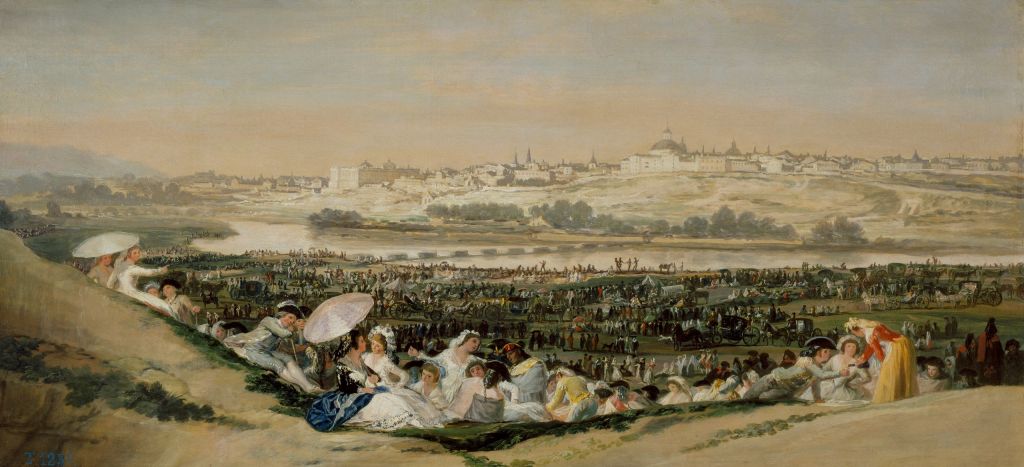
The cemetery takes its name from the patron saint of Madrid, San Isidro Labrador. (“Labrar” means to till the soil, as he was a poor farmer in life.) Isidro lived in Madrid almost 1,000 years ago, when it was a small town of little importance. Last year, 2022, marked the centenary of this saint’s canonization, and thus it was deemed a year of special celebration. But regardless of the year, every May 15th the adjacent San Isidro park fills up with revelers as a celebration of the saint’s day.
As with many catholic saints, a variety of miracle stories are told about San Isidro, one of which is that of a fountain he created by striking his staff on the ground, in order to slake his master’s thirst. This miraculous spring quickly became known for its curative properties, and it still occupies a place of honor in the cemetery.
Times have changed somewhat. To accommodate the pandemic, a motion-sensor has been added to make the fountain more sanitary. Thus, one can partake of the miraculous healing water without touching any germs. The fountain itself, though not large, is interesting for the long inscription that covers the wall. This text boasts, among much else, of having cured various types of fevers, urinary and kidney problems, erysipelas (a bacterial infection), vomiting, sores, leprosy, wounds, and even of restoring a blind person to sight. An impressive record, indeed—though I think I will stick with my current physician. Yet the fountain’s longevity is palpable, considering that it also bears an inscription of a short poem by Lope de Vega (1562 – 1635) praising the water’s power.
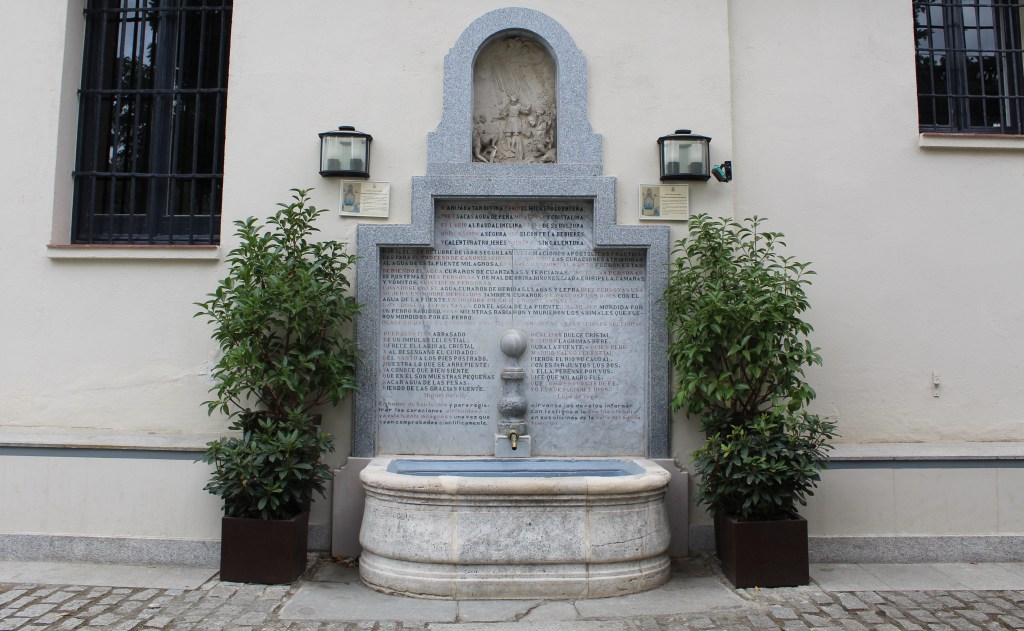
This fountain is right next to the Chapel of San Isidro. This is no coincidence, as the chapel was built on this spot in the 16th century on the orders of the Empress Isabel of Portugal, who believed that the blessed waters had cured her son, the future Felipe II. (This did not prevent poor Felipe from developing severe gout later in life.) Though a chapel has been here on this spot a long while, its current form is from the 18th century, when it was rebuilt. Thus, when Goya painted the chapel in 1788 (in another sketch for a tapestry, on display at the Prado), it looked very much as it does today. Even so, this is something of an illusion, as the chapel was—like much else in Madrid—totally destroyed during the Civil War, and only reconstructed to appear as it did in Goya’s day.

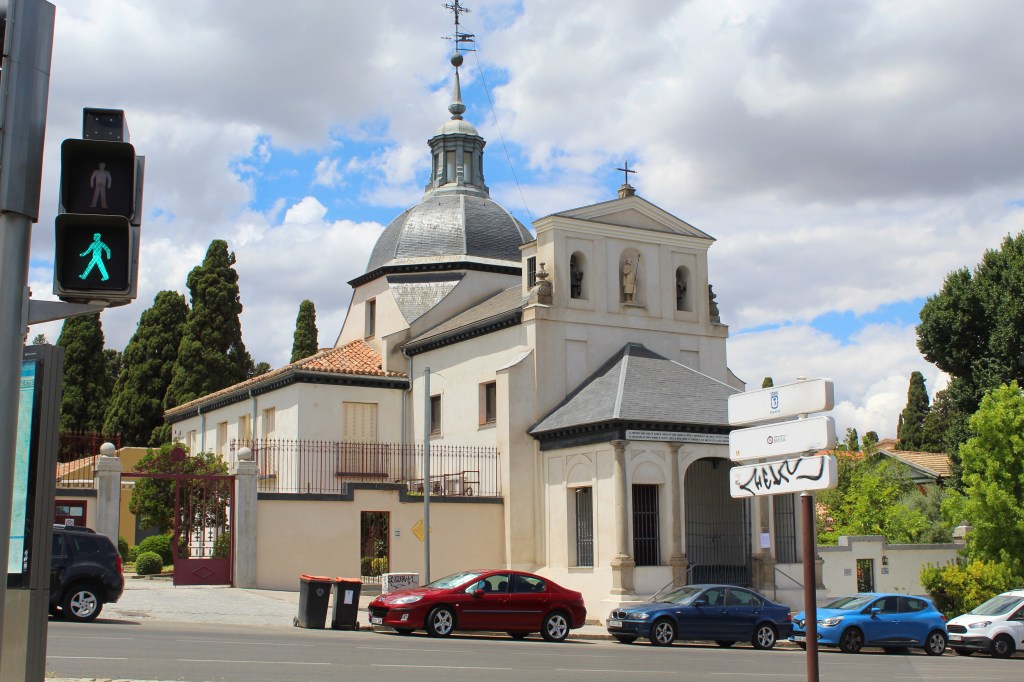
This quiet, peaceful cemetery was in the news last year as the site of a fascist demonstration. About two hundred Falangists (the Spanish fascist party) gathered to protest, hold up signs, and wave the Nazi salute. This was occasioned by the re-interment of the remains of one José Antonio Primo de Rivera (1903 – 1936), the founder of the Falangist party.
Ironically, Primo de Rivera became more important in death than he had ever been during his short political career. The Falangists were never a major electoral force during the Second Republic, and José Antonio did not help plan or execute the military coup which eventually resulted in Franco’s dictatorship. Rather, he became something of a martyr when he was imprisoned and then executed by the Republicans during the first year of the Civil War. After Franco emerged victorious, he found it convenient to treat Primo de Rivera as a kind of John the Baptist to his Messiah, and had Primo de Rivera’s body transported from Alicante to Madrid in a massive funeral parade.
After this, Primo de Rivera was temporarily laid to rest under the altar in El Escorial. But when Franco’s enormous symbol of fascist power—The Valley of the Fallen—was completed in 1959, Franco had the body moved once again, to serve as the symbolic centerpiece to his monument to the Civil War dead. For decades, Primo de Rivera slumbered underneath the mosaic dome of the underground basilica, directly opposite Francisco Franco’s own body.
Yet having such ghastly figures entombed in such a place of honor naturally bothered a lot of people, for the same reason that having statues of Confederate generals disturbs many Americans. The Valley of the Fallen was argued over for years until, in 2019, Franco’s body was dug up and moved to a cemetery in El Pardo. In 2023, the job was finished when Primo de Rivera’s body was also removed (the third time this embattled body has been re-buried, if you’re counting). Indeed, the official name of the site is no longer the Valley of the Fallen, but the Valley of Cuelgamuros.
Such is the hold of fascist propaganda on people’s minds that, decades after the fall of Franco’s dictatorship, and nearly a century after Primo de Rivera’s death, people still showed up to protest for the sake of these old bones.
Enough politics! It is finally time to enter the cemetery itself. As the map by the entrance informs us, the cemetery is divided into several “patios.” The first three are located on a level with the chapel and are rather like church cloisters, without much decoration. The most interesting part of the cemetery is, without doubt, the large, semi-circular fourth patio.
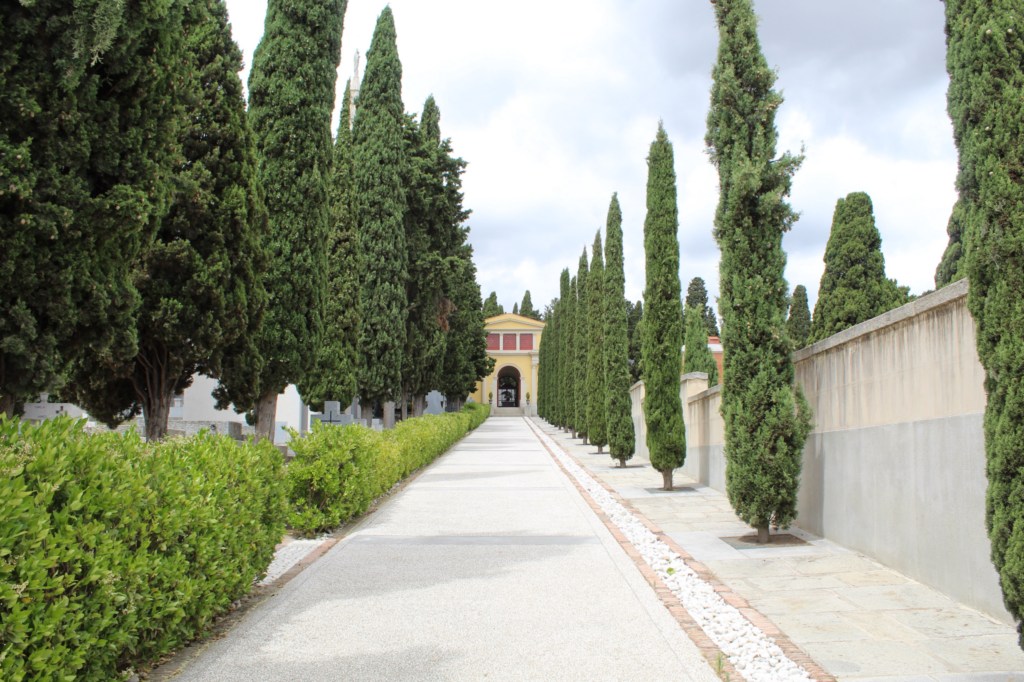
A walkway, lined with cypress trees—the traditional tree of mourning—leads up a hill to the upper level. It is obvious at a glance that this used to be a very fashionable place to decompose. The place is covered in elaborate tombs, mausoleums, and monuments—clearly not a burying ground for the penny-pinched. Look behind you, and you can see part of the reason for its popularity: The views of the city are quite wonderful from here (presumably why it was popular for picnics back in Goya’s day).

There are many eye-catching sculptures on display. But the first I want to discuss is a rather puzzling monument.
In a previous post, I explored the often-overlooked Pantheon of Illustrious Men, located near Atocha. The Cemetery of San Isidro has what can only be described as an aborted first attempt at that same monument. Also called the Pantheon of Illustrious Men, it consists of a tall stone pillar, upon which an angel stands with his trumpet. At the bottom of this column there is an ornate base with carved reliefs of the extremely distinguished bodies which rest beneath it. Three of these four are people the reader is unlikely to have heard of (illustriousness notwithstanding), but the fourth is none other than Francisco Goya, a person who is famous indeed.

The painter’s posthumous presence here is puzzling for two reasons. For one, this monument was not completed until 1886, while Goya died almost sixty years before that, in 1828. Second, I happen to know that Goya is certainly buried in a different chapel, not far off, called San Antonio de la Florida.
This mystery has a clear—if not exactly a logical—explanation. Goya was first buried in Bordeaux, France, where he died in exile. His body rested there, unharassed, for several decades until it was chanced upon by the Spanish diplomat to France, whose wife was coincidentally buried in the same cemetery. Obviously, the glorious Aragonese painter could not be left to decay on foreign soil, so he was relocated to his native land, and taken to this cemetery. However, because of all the bureaucratic hassle of transporting a body, Goya’s bones did not arrive until 1899, by which time the original idea of the Pantheon had lost its luster. Thus, he was instead buried in the aforementioned chapel of San Antonio de la Florida, which he had decorated with his own hand.
(To make the matter even more confusing, this chapel was eventually deconsecrated and turned into a museum, while an identical chapel was built just across the street—to the delight of many potential visitors, I am sure. And, to top it all off, Goya’s skull was lost at some point during this process, never to be found again. To add to the mystery, there is a painting in the Museum of Zaragoza of what is supposed to be Goya’s skull, made in the year 1849, before any of this tomb switching went on. It is possible it was stolen by curious admirers.)

We have spent a lot of time on this odd cenotaph, but there is a great deal more to see in the cemetery. Indeed, I have seen enough cemeteries so that I can confidently proclaim that the Cementerio de San Isidro is among the most beautiful in Spain—perhaps in all of Europe. The finest artists and sculptors of the time were hired to turn a place of mourning into a wonderful open-air gallery. Of course, this was not an act of public service. This was done to preserve and glorify the names of the rich and famous—who wanted their final resting places to reflect the splendor of their lives.
It would be impossible to review every notable tomb and name in the cemetery. The following is only a brief sampling of what you may find there.
By the standards of the cemetery, a relatively modest grave belongs to Cristobal Oudrid, an important composer of zarzuelas (the distinctively Spanish version of light opera). His mustachioed face, carved into the stone, keeps watch over his earthly remains. Not far off is the resting place of Consuelo Vello Cano, better known by her stage name Fornarina. She performed a genre of song called cuplé, considered somewhat risquée, which was normally sung by women (or men in drag) for an all-male audience. Her grave is presided over by the torso and wings of an angel. An extremely modest grave belongs to Ventura de la Vega, an Argentinian playwright who lived and worked in 19th century Spain. He is buried in a niche in the encircling walls of the patio.

But what naturally attracts the casual visitor are the big tombs. Perhaps the most eye-catching is the Panteón Guirao, a massive sculptural tour de force by Augustín Querol. Querol is also responsible for a monumental tomb in the Panteón de Hombres Ilustres in Atocha, and this work displays his ability to create dramatic, fluid, and even ghostly textures out of hard stone. This tomb—which occupies the center of the patio—was made at the behest of Luis Federico Guirao Girada, who was a lawyer and a politician during his life, but who is now principally remembered for his photography.
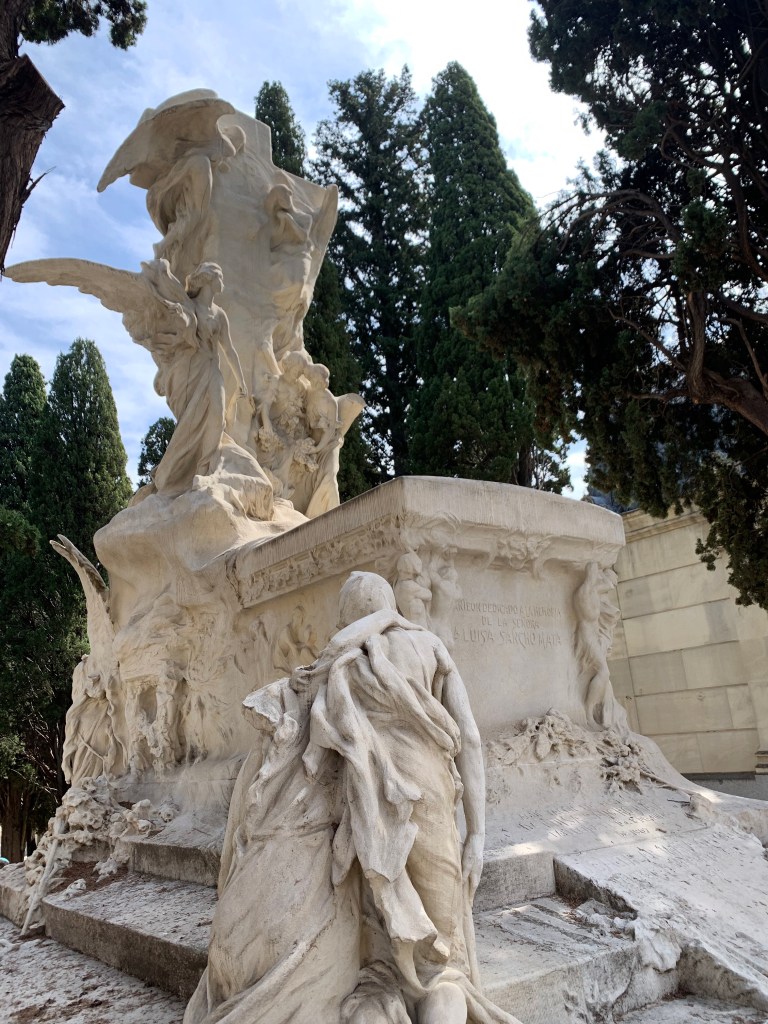
An extraordinary tomb is that which belongs to the Marquis of Amboage, an aristocratic family. This is an enormous neo-gothic chapel, bristling with prongs and complete with a metal spire, much like that of Notre-Dame de Paris. It could be a church if it did not have permanent tenants. But my favorite tomb is that of Francisco Godia Petriz. Petriz had a successful import-export business but was also an avid art collector. His mausoleum is unlike any I have ever seen. A stone sarcophagus hangs suspended by heavy chains from a large rectangular frame. The frames are held by miniature angels, who are ready to literally and figuratively carry the dead businessman up to heaven. Even if it is a bit tacky, I think the design is so original that I am surprised its architect, José Manuel Marañon Richi, is not better known.

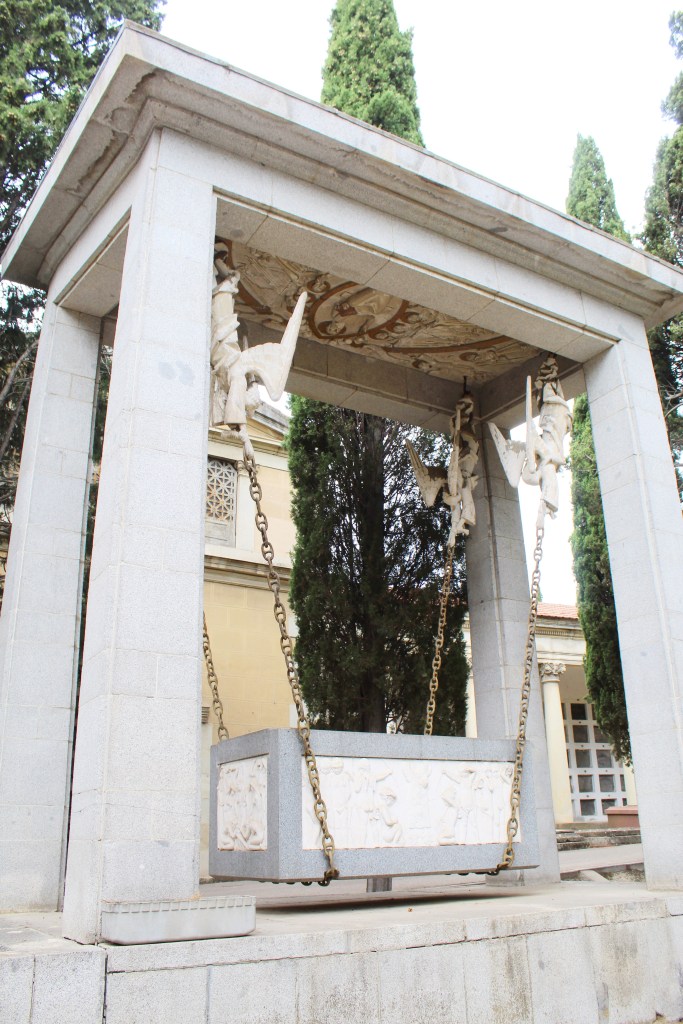
Some of the jewels of the cemetery are only available for those taking the official guided tour. These are offered only every so often and are all in Spanish. If you do manage to get one, however (they are reserved by emailing the cemetery), then you may be taken inside some of these impressive tombs. In the tomb of the Dukes of Denia, for example, there are two statues by the Spanish sculptor Mariano Benlliure, who vividly depicts the Duke and Duchess lying in deathly repose. Even more stunning is what awaits the visitor of the tomb of the Marquis of la Gándara. Inside, sitting atop a sarcophagus, is an angel wistfully looking into the beyond. This is a work of the Italian sculptor Giulio Monteverde, and it is quite wonderful. Standing in front of this heavenly being, it is easy to forget that she is made of inanimate rock, so subtly lifelike is the work in every detail.
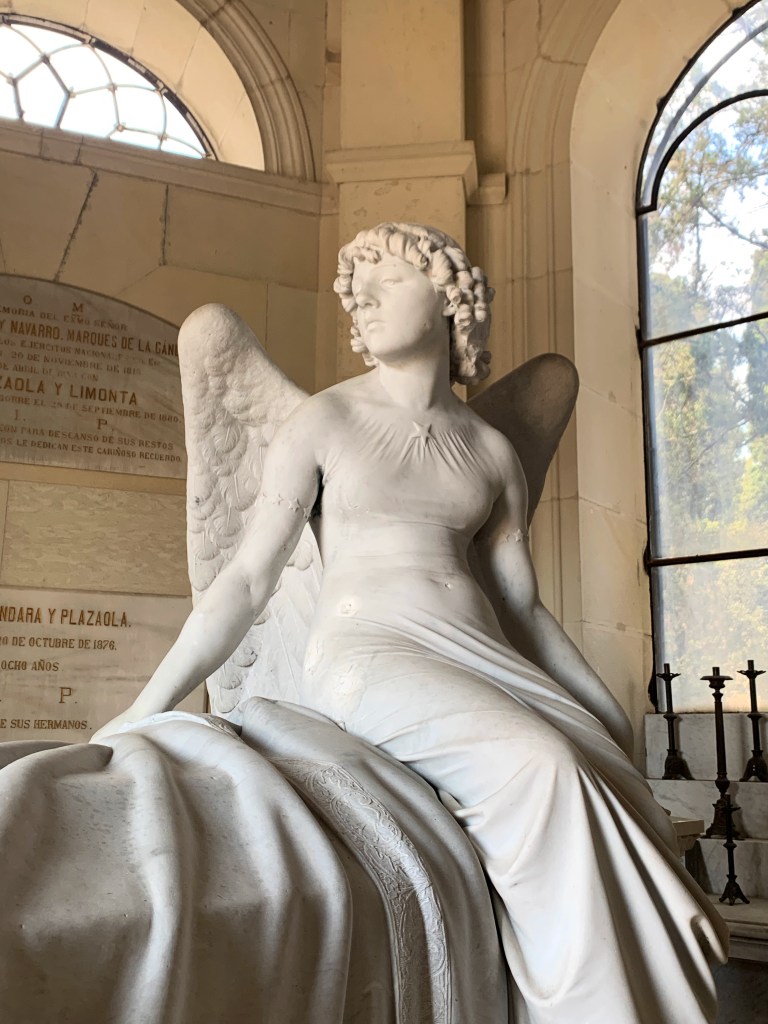
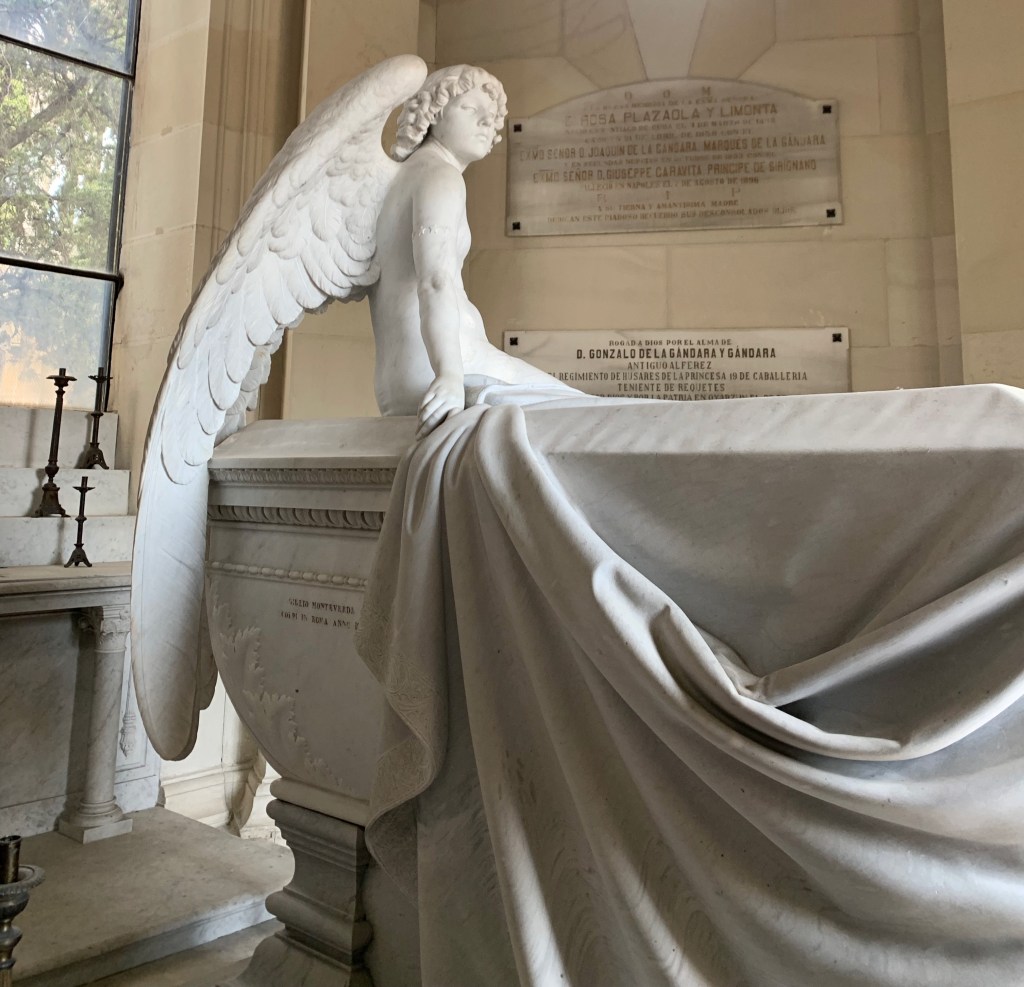
If I am dwelling on this cemetery for so long, it is because it was a revelation to me that such a beautiful place was to be found in the city, virtually overlooked as a tourist destination. If Pére Lachaise Cemetery deserves to be on every Parisian tourist’s itinerary, then the Cementerio de San Isidro merits the same—both as an important link to Madrid’s history, and a place beautiful in itself.
Review: Get the Picture
Get the Picture: A Mind-Bending Journey Among the Inspired Artists and Obsessive Art Fiends Who Taught Me How to See by Bianca Bosker
My rating: 5 of 5 stars
Much like Michael Pollan’s Omnivore’s Dilemma, I feel compelled to give this book top marks—not because I agreed with everything Bosker said, and not because I loved every moment of it—simply because I doubt a better book could be written about its subject. Bosker threw herself at the world of contemporary art with the devotion of a fanatic and the patience of a saint. This book represents, in a very real sense, a decent chunk of Bianca Bosker’s life. Years went into it.
The comparison with Pollan is apt, as—like the food writer—Bosker is a kind of experiential journalist. She is not content to read art theorists and to visit a few galleries. No, she must work for a gallerist, apprentice with a painter, watch over the art in a museum, sell paintings in a show, plan an exhibition—in short, she must do everything that anyone involved in the art world does. And in so doing, she painstakingly assembles a map of this small, strange world.
The (ahem) portrait that she paints of this world is not flattering. This is especially true of the first part of the book, in which she becomes an assistant to a hip Brooklyn gallerist, Jack Barrett. I must say that I found Barrett to be the most unlikable person I had read about in quite some time—and I am including the murderous cannibals in The Road. He epitomizes everything unsavory in the art world: an obsession with reputation, with coolness, with inaccessibility, with fitting in—with everything, in short, except the art itself.
Like many gallerists, apparently, he prefers a property on an upper floor, so that it doesn’t attract street traffic. Visits from ordinary people—so-called ‘schmoes’—are to be avoided at all costs, as their appreciation is worse than worthless: it is detrimental. He even contemplates, at one point, hiring a web designer to make his website as difficult to use as possible, perhaps with white font over a white background. (Judging from his current website, this was wisely decided against.)
This emphasis on inaccessibility is certainly reflected in the language of the art world, whose style will be familiar to anybody who has been in academia. Probably many of you have had the experience of seeing something incomprehensible in an exhibition, turning to the plaque for guidance, and being confronted with a text that only adds to the confusion. As Bosker notes, this style of writing came into vogue in the 20th century, modelled after the French deconstructionists—whose already turgid prose was translated into highly unidiomatic English, and then emulated by anglophone writers. It is, in short, language meant to mystify and intimidate, not enlighten.
Most importantly, in Mr. Barrett’s world, “context” is king—which is really just a pretentious word for “reputation.” He is constantly worried about whether the people he is talking to are the “right” sort of people, in the sense that doing business with them will bolster his own reputation. When deciding whether to represent an artist, his most important question is whether they are the sort of person he would like to hang out with. He even goes so far as to nitpick Bosker’s clothes and to coach her behavior—not too many questions, no complements, no staring at the art—during their visits to galleries, since he doesn’t want her to taint his own manicured reputation.
The final irony is that Barrett, like so many in the art world, does so much of what he does in the name of progressive values, while personally betraying them. Several times, for example, he berates older painters and art critics (like Kenneth Clarke) for their focus on the female body, but he has no problem openly criticizing Bosker’s outfits, and even her exercise habits. He is critical of the white male establishment while being, quite obviously, a part of it—someone who is certainly from a rich family, but who hides his background so as to conceal his own privilege. And he is far from an aberration: as Bosker points out, the majority of galleries are owned by white males.
I am probably spending too much time on Barrett, who really only occupies the first quarter of the book. But I found his entire attitude towards art to be so poisonous that I could hardly even believe that such a person could really exist, much less be (as Bosker insists) one of the ‘nicer’ gallery-owners in New York. Yet perhaps the most damning fact is that, as Bosker points out, Barrett rarely if ever comments on the formal qualities of a work. In the rare moments that he deigns to explain why he likes a particular piece, he resorts to interpretations that rely on his knowledge of the artist—of “context,” in other words. If the book consisted solely of Bosker’s experience with Barrett, one would have to conclude that the art world was entirely and utterly vapid.
But Bosker has an incredible capacity for hope; and even after her tense working relationship with Barrett breaks down completely (he implies that he purposely told her the wrong way to paint a wall, so that he could criticize her for doing it wrong), she persists and actually succeeds in meeting some pretty nice people. The next gallerists she works for tell her, contra Barrett, to “stay in the work”—to appreciate the art you see in front of you, and not fall back on its reputation. And rather than insist on a frigid dress code and an affectless demeanor, they are bouncing off the walls with enthusiasm for the art they sell.
Yet the hero of this book is, undoubtedly, Julie Curtiss. With all of the focus on gallerists, curators, and collectors in the beginning half of the book, it is easy to forget the actual people who make the art. And Curtiss, whatever you think of her work, is every inch an artist—manic about her craft, able to talk your ears off about color, a perfectionist in every detail, and motivated by a kind of ineffable aesthetic vision. In stark contrast to the Barrett camp of art, Curtiss seems motivated purely by the formal qualities of her work—a vision in her head that she is trying to make manifest. What it means—whether it means anything—is of far less significance.
Bosker ends the book by taking her own stab at the question: What is the value of art? She decides that art works by reuniting us with the basic data of our senses. As she notes, our brains are constantly taking the information from our eyes and fitting it to preconceived patterns, which aid us in quickly making sense of what we experience. The advantage of this is greatly increased processing time (we know a lion immediately when we see one), but the disadvantage is that we can become disconnected from the real stuff of experience. Art breaks this pattern by presenting images to our brains that we can’t immediately make sense of.
Now, I think there is a great deal to be said for this view. For one thing, it avoids the over-reliance on “context” that plagues so much modern art—a sculpture of a coffee mug that comes with an essay about modern-day consumerism. However, as an attempt to come to grips with art it strikes me as both too broad and too narrow—too broad, in that many things besides art can reconnect us with our senses (travel, drugs, exercise…), and too narrow, in that art can do more than just attune us to the beauty of color and form. Yet it is difficult to criticize Bosker on this point, given that Plato and Kant also tried and failed to come up with an all-encompassing philosophy of art.
In any case, before writing this review, I made sure to try to put Bosker’s advice into practice. Last Saturday, I went to the Reina Sofia museum and forced myself to stare at art that, otherwise, I would probably have scornfully walked right by. As she advised, I tried to notice at least five things about each work I focused on, and even set a timer on my watch for five minutes, not allowing myself to move on until the time ran out. Perhaps this sounds more like a form of self-hypnosis or meditation than genuine art appreciation, but I did find myself enjoying some rather far-out contemporary works that were not to my usual taste.
And it is a great testament to Bosker’s book that, in spite of the (ahem, ahem) ugly picture she paints of the art world—so full of empty pretensions and hypocrisy, a “progressive” world of starving artists and rich collectors—that despite all this, she still deepened my enjoyment of contemporary art. It is a masterpiece.
View all my reviews
Cover photo by Wallygva at English Wikipedia, CC BY-SA 3.0, https://commons.wikimedia.org/w/index.php?curid=15372441
Review: The Assassination of García Lorca
El asesinato de García Lorca by Ian Gibson
My rating: 5 of 5 stars
Sometimes the simple act of remembering is political. History is, unfortunately, replete with crimes that one government or another would prefer to remain hidden. And, certainly, forgetting is probably easier for everyone involved—less traumatic, more convenient—even, perhaps, for the victims. Thus, whenever some busybody like Ian Gibson begins stirring up old trouble, the accusation of “opening up old wounds” is inevitably trotted out (ironically, by the ones who did the wounding in the first place).
And yet, even if it is not entirely logical—even if what is done is done, and nothing can change that—some sense of moral duty, of obligation to victims who are beyond all human help, seems to compel us nevertheless to reach back into the past and seek justice. This book is imbued with that sense—perhaps a quixotic sense—of ethical duty, as Gibson attempts to nudge the moral balance of the universe back in the right direction.
He first establishes that Lorca was anything but the apolitical flower child that he is sometimes portrayed as. It is true that Lorca was perhaps somewhat naïve and, in general, was averse to party politics (he repeatedly refused to join the communist party). But he was politically active and unambiguously allied with the left, as was evident by several public declarations. Indeed, the idea that Lorca was, in his final days, converting to the fascist cause—an openly homosexual poet who dramatized the evils of conservative Catholicism!—was never anything but laughable.
Gibson then does his best to establish the events that lead to Lorca’s death in Granada, using interviews with witnesses (admittedly many years after the fact) to pin down as many details as he can. In the process, he gives the reader a sense of the climate of terror and repression that engulfed Granada in the opening days of the military uprising—jails packed to bursting, mass graves filled by firing squads, a knock on the door at mightnight to go “take a walk.” In the process, he also lays to rest another myth of Lorca’s murder, that he was somehow killed by uncontrollable elements of the falangist party—a random act of violence, in other words. On the contrary, Lorca’s death was the product of an intentional campaign of “purification,” approved of and organized by the authorities.
This book might not have had such an impact on me had I not visited Granada as I was on the final pages. Though I had read many of Lorca’s works before the visit, he was still just a historical personage for me—one of Spain’s many dead poets. But visiting his former houses (there are several, as his family was very wealthy) transformed him into somebody startlingly real and close. I saw the piano that he liked to noodle on, the writing desk on which he wrote his most famous plays, and even hand-drawn theater backdrops to be used in a puppet show for his baby sister.
This trip culminated in a visit to the Barranco de Víznar, the place of his execution. We arrived on a foggy Sunday morning and followed the path into the woods. Soon, we came upon several white tents, which covered the excavations sites of mass graves. The trees around the site were covered with laminated posters bearing the names and faces of those executed there—professors, politicians, farmers, pharmacists, music teachers… In the center was a simple memorial covered in flowers, with the inscription “They were all Lorca.”
So far, the remains of dozens of individuals have been recovered there by a team of investigators, though none have yet been identified by DNA tests. That this excavation had to wait nearly 100 years to take place is a measure of the silence—imposed, in an attempt to forget—that followed the Spanish Civil War. But relatives of the victims have kept their memories alive, and now they are perhaps receiving some modicum of justice. Even today, memorializing these victims takes courage. Just last week, a hiker was assaulted at that very place by a man screaming “There aren’t many buried here!” The hiker was hospitalized. But the work continues.
View all my reviews
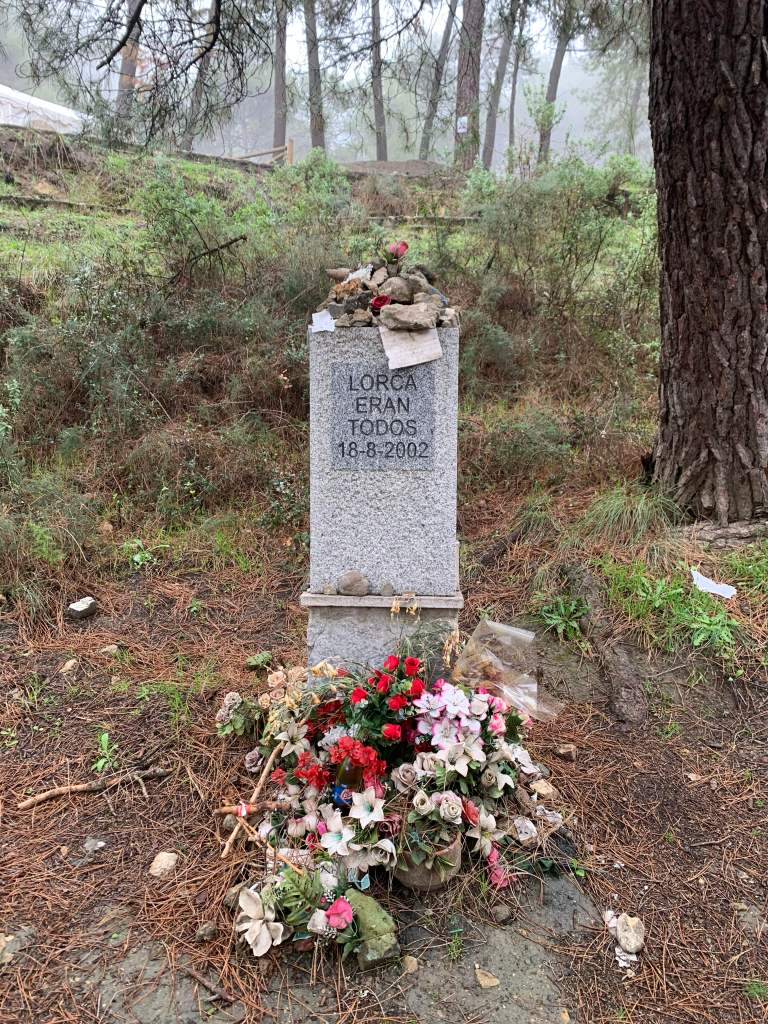
Quotes & Commentary #82: Tolstoy
In historical events great men—so called—are but the labels that serve to give a name to an event, and like labels, they have the least possible connection with the event itself.
Leo Tolstoy
Anyone who has made it to the end of War and Peace will remember the strange sensation of finishing one of literature’s most epic stories and immediately being thrown into—of all things—an essay on the philosophy of history. With your heart throbbing with emotion for the characters who made it to the end of the novel, you are hardly in a fit frame of mind for considering the deep mechanisms of historical progress.
Tolstoy himself may not even have been in a fit frame of mind, as his essay—while well-written and interesting—is not exactly persuasive. Indeed, the famous philosopher Isaiah Berlin wrote one of his most famous philosophical essays, “The Hedgehog and the Fox,” analyzing why a man as brilliant as Tolstoy could put forward a work of analysis that does not really hold together. In Berlin’s opinion, Tolstoy is a classic “fox” trying to be a “hedgehog”—meaning, that although Tolstoy’s brilliance was expansive and intuitive, born of his great gift for empathy, he longed to be a systematic thinker who could subject his life to logical conclusions.
Tolstoy’s particular gifts aside, let us turn to the main argument of his essay—namely, that the “Great Man” theory of history is a mistake. Tolstoy argues that, although we conventionally ascribe major historical events to the decisions of certain powerful individuals, it is more accurate to think of history as the product of a countless number of choices and actions by everyone involved. To use Tolstoy’s own example of Napoleon, he argues that, although Napoleon is treated as a kind of mortal god who changed European history—a military genius who defeated so many foes—in reality he was usually unaware of what was happening during his major conflicts, and entirely powerless to influence the outcomes of his battles.
Now, I think nearly everyone would say that Tolstoy pushes his point too far. I doubt many historians would be willing to argue that Napoleon was not a particularly important man, who certainly did exert an influence on the outcome of his battles. Nevertheless, the opposite opinion —say, that Napoleon was wholly in control of his destiny—can also easily be taken too far. Indeed, as far as I can tell, amid historians nowadays there is quite a bit of hostility to the “Great Man” view of history.
I hate to be the sort of person to argue for a middle ground. “It is a little of both” is the oldest intellectual cop out in history. Nevertheless, it does seem logically inescapable that “men” (or, to be a little more inclusive, “people”) are both products of their times and makers of events. The more interesting question is to what extent any given individual is crucial to the shape of history.
The most convincing proponent of the “Great Man” view of history I know is Robert Caro (whose tomes make even War and Peace seem lightweight). In his biography of Bob Moses, for example, Caro makes a convincing case that Moses was a uniquely gifted administrator—an expert in the accumulation and deployment of political power. The very shape of New York City—its many highways, bridges, and tunnels, its parks and housing developments—is, for better or worse, a testament to Moses’s influence.
But a skeptic might say that, as special as Moses might have been, cities all over the United States implemented similar programs—bulldozing neighborhoods for highways, demolishing buildings to create high-rise public housing. If Moses was really so special, then why did he merely accomplish what was basically accomplished all around the country by far less famous individuals?
This rebuttal works in the abstract but not the concrete (pun intended). In Caro’s telling, you can see exactly how Moses subverted rules, bypassed regulations, and bent politicians and contractors to his will, in a way that was completely unprecedented. After witnessing his machinations, it is very difficult not to be convinced that, at the very least, Moses’s specific personality and prejudices carried historic weight.
This is not to take the opposite view, that so-called “Great Men” are the only ones who count in history. It is just to make the claim that, while every individual can exert some influence on the shape of history, some individuals wield considerably more influence than others. And while this may feel like a cop-out, arguably both Tolstoy’s view or the opposite extreme are anti-humanistic—the former, because individual qualities are held to play no role in history, and the latter, because the majority of humankind are reduced to automatons carrying out the will of a few geniuses on top.
I will cease to belabor this point—which I suspect will seem rather obvious to most—as it is just another form of the “chicken and egg” problem. I will only add that, as an amateur student of history, I think it is greatly rewarding to consider the individual experiences of both the major players (the so-called “Great Men”) and the supposedly “ordinary” people on the bottom. It all has much to teach us.
Quotes & Commentary #81: Pirsig
We have artists with no scientific knowledge and scientists with no artistic knowledge and the results aren’t just bad, they’re ghastly.
Robert Pirsig
Among the many woes of American higher education nowadays, one is the precipitous decline of the humanities. Students these days, apparently, are opting for science, business, or engineering degrees, rather than the liberal arts. And as administrators slash budgets in history and literature departments in response to this declining enrollment, some writers and educators have stepped forward to defend this ancient, noble pursuit.
David Brooks attempted a sort of defense recently, in his column “How to Save a Sad, Lonely, Angry and Mean Society.” His argument was essentially that exposure to great works of art develops empathy, as great art trains us to see the world through different perspectives. It is Brooks’s belief and hope that such exposure translates to moral behavior. After all, if we can appreciate the needs, thoughts, and beliefs of others, we will certainly be more kind to them.
I would very much like to agree with this argument. But I have a hard time swallowing it. For example, one of the artists that Brooks mentions is Pablo Picasso, whose great painting Guernica arguably improves its viewers by making the horrors of war viscerally palpable. Picasso himself was, however, a notorious abuser of women, despite being as steeped in art as a person can possibly be. Indeed, history is so replete with cultured criminals—many prominent Nazis were highly educated connoisseurs, to pick just one notorious example—that the notion of betterment through studying the humanities can seem rather silly.
And yet, it is difficult for me to entirely let go of this idea. As a counterpoint, I might mention the American Secretary of Defense, Robert McNamara. After watching Errol Morris’s wonderful documentary about McNamara, one is left with the impression of a man dominated by instrumental thinking. That is, McNamara is always concerned with the how of any question—and he is content to let his superiors worry about what he is doing, why he is doing it, and whether he should be doing it in the first place. Put another way, I think McNamara illustrates the limitations of a purely technical mind—even a brilliant one—as he attempts to make a stupid, immoral war machine as efficient as possible.
Perhaps it is fairer to say, then, that the humanities, while not sufficient for moral behavior, are a necessary condition of it. Or perhaps one must make the even weaker argument that, in general, exposure to philosophy, literature, history, and the arts tends to make us more moral. Or perhaps we might even have to take one further step back, and resign ourselves to saying that these subjects give us an opportunity to at least consider how we could become more moral. If that isn’t convincing, then we ought to just admit that the humanities are valuable simply because they make life more pleasant and interesting—which should be enough, anyway.
What does seem quite clear to me is that all the humanities and arts in the world will not be enough to extricate us from the moral morass that the United States—and, to a worrying extent, much of the rest of the world—seems to have fallen into. Individual enlightenment, even if it is achievable, does not stand much of a chance against collective stupidity. As dirty and disheartening as it is, we must participate in politics as partisans if we want to create a better world.
In any case, I think the decline in student enrollment in the humanities should not be ascribed simply to the deterioration of our culture or the coarse values of the new generation. A huge part of the explanation is simply cost. It is one thing to, say, hold history or philosophy in high esteem, but quite another thing to decide to go into thousands of dollars of debt to acquire such knowledge, with no assurance of a decent job on the other end. Expensive universities only make financial sense if they lead to a good career. (Having studied anthropology, I am in no position to be moralizing on this topic.)
In many ways, the university system here in Spain seems more logical to me. Rather than living on a luxurious campus and indulging in the life of the mind, most university students here commute from home, pay a modest fee, and learn exactly what they need to work in a specific job. In other words, it is job training, pure and simple (at least for most people).
And yet, I am old-fashioned enough to think that there is something good and valuable in the old liberal arts model of education, even if it is difficult to justify on economic grounds. Like Pirsig, I shudder to think of a world where people are only familiar with their own specialty, be it science or art. Education should not be reduced to technical training, or we will be left with a society of people unable to think about problems beyond the narrow domain of their fields. But how can the humanities be kept alive amid the ballooning cost of universities and the dwindling job opportunities of the market? This is a question beyond my ken.







